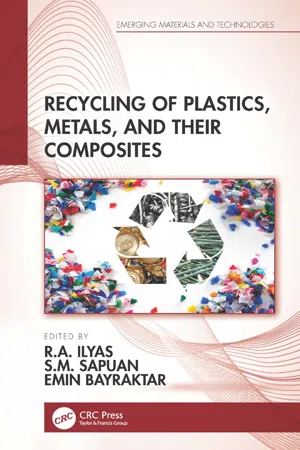
Recycling of Plastics, Metals, and Their Composites
- 519 pages
- English
- ePUB (mobile friendly)
- Available on iOS & Android
Recycling of Plastics, Metals, and Their Composites
About This Book
Having a solid understanding of materials recycling is of high importance, especially due to the growing use of composites in many industries and increasingly strict legislation and concerns about the disposal of composites in landfills or by incineration. Recycling of Plastics, Metals, and Their Composites provides a comprehensive review of the recycling of waste polymers and metal composites. It provides the latest advances and covers the fundamentals of recycled polymers and metal composites, such as preparation, morphology, and physical, mechanical, thermal, and flame-retardancy properties.
FEATURES
-
- Offers a state-of-the-art review of the recycling of polymer composites and metal composites for sustainability
-
- Describes a life-cycle analysis to help readers understand the true potential value and market for these recycled materials
-
- Details potential applications of recycled polymer and metal composites
-
- Includes the performance of natural fiber–reinforced recycled thermoplastic polymer composites under aging conditions and the recycling of multi-material plastics
-
- Covers recycling technologies, opportunities, and challenges for polymer-matrix composites
This book targets technical professionals in the metal and polymer industries as well as researchers, scientists, and advanced students. It is also of interest to decision makers at material suppliers, recycled metal and polymer product manufacturers, and governmental agencies working with recycled metal and polymer composites.
Frequently asked questions
Information
1 Introduction to Recycling of Polymers and Metal Composites
- 1.1 Introduction
- 1.2 Properties of Recycled Metal Composites
- 1.2.1 Mechanical Properties
- 1.2.2 Chemical Properties
- 1.2.3 Physical Properties
- 1.2.4 Thermal Properties
- 1.3 Recycling Method of Polymer and Metal Composite
- 1.3.1 Mechanical Recycling
- 1.3.2 Chemical Recycling
- 1.3.3 Thermal Recycling
- 1.4 Impact of Recycling Polymer and Metal Composites on Environment, Industry and Economy
- 1.5 Recycling of Polymer Composites
- 1.6 Metal Recycling Composite
- 1.7 Conclusions
- Acknowledgment
- References
1.1 Introduction



1.2 Properties of Recycled Metal Composites
1.2.1 Mechanical Properties
1.2.2 Chemical Properties
Table of contents
- Cover
- Half Title
- Series Page
- Title Page
- Copyright Page
- Contents
- Preface
- Editors
- Contributors
- Chapter 1: Introduction to Recycling of Polymers and Metal Composites
- Chapter 2: Preparation of Metal Matrix Composites by Solid-State Recycling from Waste Metal/Alloy Chips
- Chapter 3: A Comprehensive Study on the Recycled Aluminum Matrix Composites Reinforced with NiAl Intermetallics and TiB2–TiC Ceramic Powders
- Chapter 4: Recycling for a Sustainable World with Metal Matrix Composites
- Chapter 5: Properties of Recycled Metal Matrix Composites
- Chapter 6: Morphology of Recycled Metal Composites
- Chapter 7: Performance of Natural Fiber Reinforced Recycled Thermoplastic Polymer Composites under Aging Conditions
- Chapter 8: Physical and Mechanical Properties of Recycled Metal Matrix Composites
- Chapter 9: Thermal Properties of Recycled Polymer Composites
- Chapter 10: Thermal Properties of Recycled Polymer Composites
- Chapter 11: Flame Retardancy of Recycled Polymer Composites
- Chapter 12: Mechanical and Tribological Properties of Scrap Rubber/Epoxy-Based Composites
- Chapter 13: Design for Recycling Polymer Composites
- Chapter 14: Effect of Heat Treatment Modification on the Tensile Strength and Microstructure of X7475 Al-Alloy Fabricated from Recycled Beverage Cans (RBCs) for Bumper Beam Applications
- Chapter 15: Recycling of Multi-Material Plastics in the Example of Sausage Casings Wastes
- Chapter 16: Influence of Recycled Steel Scrap in Nodular Casting Iron Properties
- Chapter 17: Optimization of Surface Integrity of Recycled Ti-Al Intermetallic-Based Composite on the Machining by Water Jet Cutting via Taguchi and Response Surface Methodology
- Chapter 18: Wear Behavior Analysis of a AlMg1SiCu Matrix Syntactic Foam Reinforced with Boron Carbide Particles and Recycled Fly Ash Balloons
- Chapter 19: Procedures for Additions of Wastes to Cementitious Composites – A Review
- Chapter 20: Analysis of the Scientific Production of Cementitious Composites with Recycled Polymeric Materials
- Chapter 21: Cementitious Composites for Civil Construction Made with Marble and Granite Waste
- Chapter 22: Influences of the Ceramic Inclusions on the Toughening Effects of Devulcanized Recycled Rubber-Based Composites
- Chapter 23: Evaluation of Mechanical and Microstructural Properties of Low-Density Concrete with Residual (Scrap) Vegetable Fiber and Blast Furnace Slag
- Chapter 24: Evaluation of Reinforced Concrete (RC) with Different Scrap Coarse Aggregates
- Chapter 25: Influence of Iron Content on the Microstructure and Properties of Recycled Al–Si–Cu–Mg Alloys
- Chapter 26: Polymer Recycling in Malaysia: The Supply Chain and Market Analysis
- Chapter 27: Life Cycle Assessment (LCA) of Recycled Polymer Composites
- Index